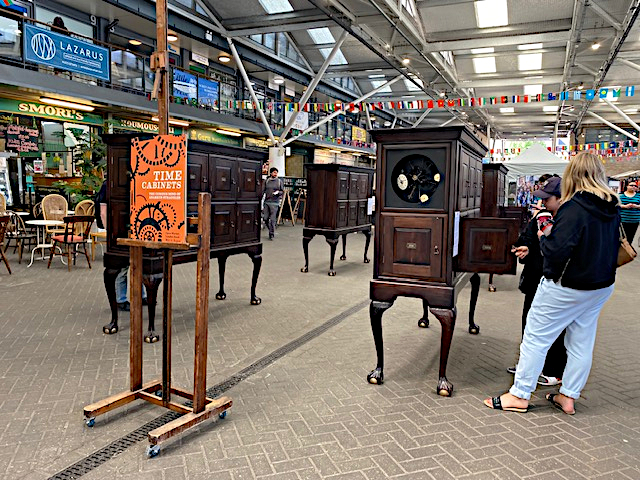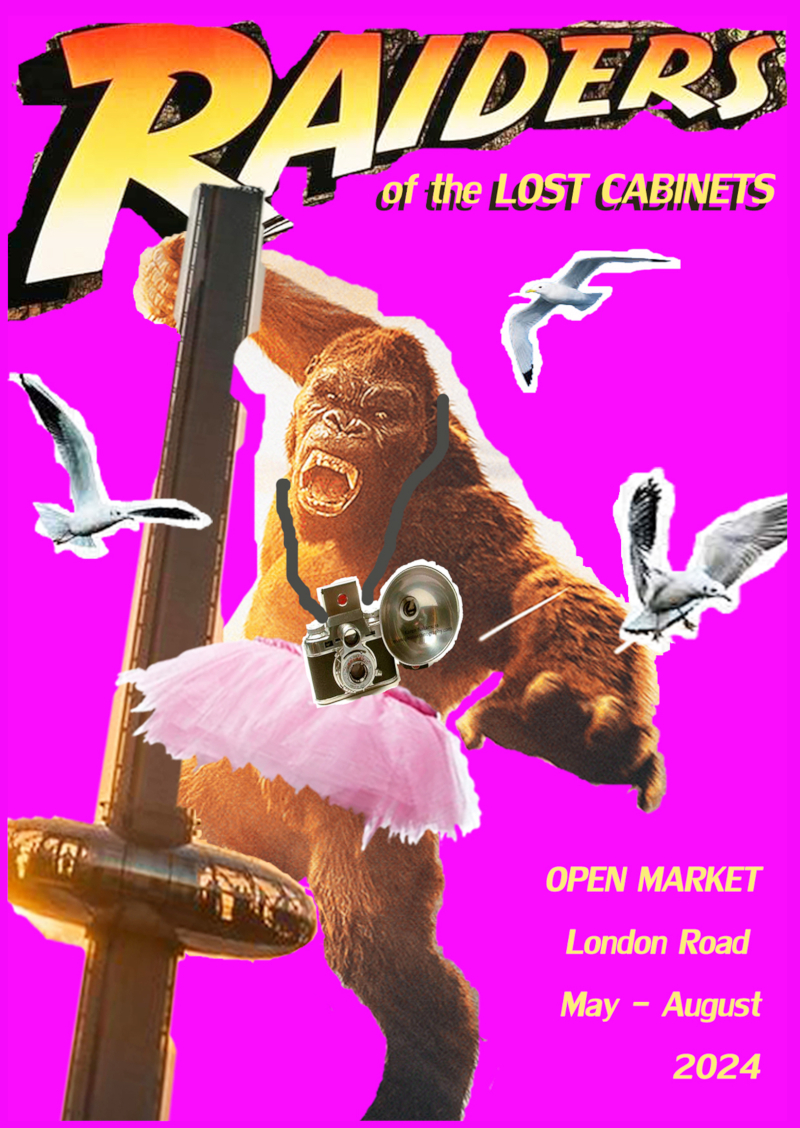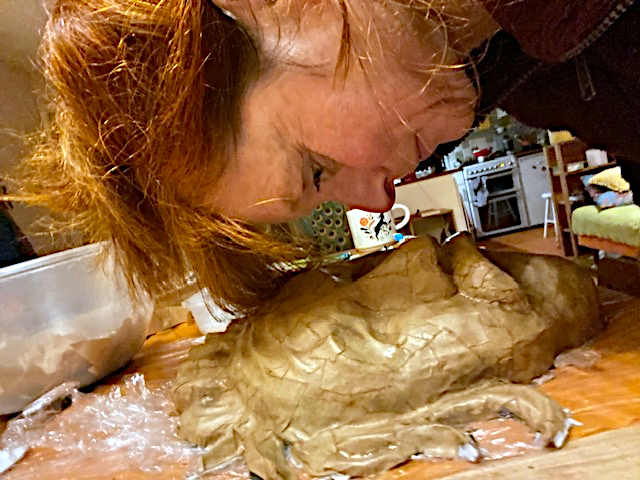Diese vier großen Schränke werden ab dem 1. Mai bis Ende August 2024 hier stehen:
Open Market Marshalls Row Entrances on both Ditchling Road & London Road, Brighton BN1 4JU E, England
„Es ist eine überdachte Marktgasse mit Cafés, Gemüse, Hippikram, Leckereien. Nachts ist sie abgeschlossen. Sie ist besucht von einer sehr bunten Vielfalt von Menschen, reich, arm, jung, alt, wild und schläfrig.“*
Was hat es mit den Schränken auf sich:
Es sind vier Schränke mit insgesamt 58 verschliessbaren Abteilen (40×40 cm groß und 15 cm tief). Also 14 Abteile in jedem Schrank. JedeR der 50 Teilnehmenden gestaltet das Innenleben eines Abteils.
Ein Gruppen-Kunstprojekt, das George Coles initiiert und zu dem er auch 2024 KünstlerINNEN eingeladen hat: JedeR gestaltet frei ein Abteil im Kasten.
Die Schränke sind in einem belebten öffentlichen Markt aufgestellt. Kinder und Erwachsene können mehrere Wochen die Türen öffnen und hineinschaun.
„Letztes Jahr (mit dem Titel „Time Cabinets“) war viel Lustiges und viel Phantastisches dabei. Das Thema war Zeit, die Schränke reichten vom Urknall bis hin zur Zukunft, auch Unendlichkeit und Kinderzimmer waren dabei.“*
Das Thema dieses Jahr ist (kurzgefaßt) Film und Fotographie. So lang es etwas mit einer Linse zu tun hat sind der Phantasie keine Grenzen gesetzt. George Coles behauptet der Titel für 2024 wäre „Raiders of the Lost Cabinets“ in Anspielung auf „Raiders of the Lost Ark„.
„Alles niederschwellig und doch mit Beiträgen von hoher Qualität. Herrlich unbürokratisch, kein Geld, kein Ruhm. Die Namen der Künstler bleiben fast unbekannt. Und das ganze steht mittendrin im Leben, keine Gallerie, kein Eintritt. Es ist einfach nur da, im Alltag auf dem Markt. Die Essenz sind Kreativität, Inspiration, Freude und Vertrauen. Simple.“*
* Wörtliche Zitate stammen von der Künstlerin Maren Danzglock, die ab dem 1.5.2024 dabei ist.




This ist the ‚back‘ story which is what the exhibition is based on:
The Raiders of the Lost Cabinets
Following on from last year’s Time Cabinets which featured ‘the curious imagination of Anarkus Straggler’ the AnArkist’s , a clandestine group of Brighton artists, have returned to focus their attention on another local life, the cinematographer, animator, photographer, Karl Angus Strager who has kindly provided the AnArkists with a list of of 93 works from the world of film, television and photography to represent in an individual box within the four cabinets.
To begin with here is a quote from Karl “The camera is a box that captures reflected light that then allows it to be viewed at leisure by others, like the pen and paint brush it is a device of imagination with which we are then able to create stories.”
Karl was born in Wetzlar, Germany in 1925, his Danish father, an optical engineer, worked on the development of the first Leica camera, his Scottish mother worked in film production for Studio Babelsburg. With the rise of Nazism during the 30’s his parents aware of looming war, sent Karl as an 11 year old boy to live with his grandmother in Helensburgh, Scotland. His parents left Germany in 1938 and his father took up work in London with John Logie Baird the pioneer inventor of television. Karl remained in Scotland with his mother. His father was killed in his workshop while working late one night during the Blitz. In 1943 Karl discovered amongst his late grandfathers possessions a Kodak Retina 35mm camera, a supply of film and processing equipment. He began photographing the aftermath of bombing raids on nearby Clydebank concentrating on the people more than the rubble, His love affair with ‘ light through a lens’ had begun.
During these war years Karl became aware of the films of Alfred Hitchcock, Michael Powell and Emeric Pressburger he cites Hitchcock who once said “There are three vital elements to great filming making: the script, the script and the script.”
In his mid twenties he moved to Oxford and worked as a film laboratory technician at St John’s college. It was here he was first introduced to the work of the great photographers Henri Cartier Bresson, Andre Kertesz, and the Swiss photographer Robert Frank’s whose gritty grainy ‘The Americans’ epicted the underbelly of society. In 1962 he started his foray into low budget film making, shooting in black and white on the streets with a borrowed 16 mm camera, processing and editing the results himself. He was very influenced by the 1966 Pontecorvo’s classic film ‘Battle of Algiers’ which remains today as one of his favourite films.
In 1970 he arrived in Brighton and set up his own studio/darkroom, over the next 40 years he produced various short films and photographic books amongst them, ‘Dead Mans coat’, ‘My Life as a Fox’, ‘This is Rubbish’ and “Bee’s Elbows’ all of which display his characteristic love of dark humour and irony. At the end of the late 1980’s he spent three years in Berlin and Eastern Europe filming and photographing the collapse of the Iron Curtain. During this time he worked with the Russian director Andrej Tarkovsky and till this day remains a devoted fan of the Czech film maker, animator and artist Jan Svankmajer who once wrote “Imagination is subversive because it pits the possible against the real. That is why you should always use your wildest imagination. Imagination is the biggest gift humanity has received. Imagination makes us human.”
Asked why he personally still chooses black and white as his own preferred medium, he answers “It is like being the rabbit in Alice in Wonderland, I feel myself disappearing down a hole into a parallel world that exists alongside me at all times”. He remains a fan of film rather than pixels and compares the difference by saying “analogue is cooking your own supper, digital is buying a takeout, both are tasty, but one has the touch of hand and soul that the other doesn’t.”
He realises though that times have changed and the use of new technologies has widened the world of how, when, where we can view and produce images. “I am intrigued by all works of the camera, high brow films, television soaps, documentaries, quiz shows or even holiday snaps, there is something for us all, from the smallest child to the oldest living person. We live in a world of images whether moving or static.”
For his 90th birthday he was honoured by having a Brighton Transport bus named after him.
Karl at the age of 99, a committed vegetarian, still lives in an independent ‘off grid’ life in the Sussex countryside along with his Australian wife Esmerelda the renowned fashion and shoe collector. He still gets out and about with a camera but his interests now lie more with growing his own vegetables, feeding the birds and animals that visit his home. He quotes Mark Twain “the more I find out about people the more I like my dogs”.
Questions to George Cole – and my answers:
Q: Until when are the cabinets in the market?
a: Until the end of August, by which time I’ve had enough and so have the people of Brighton.
Q: How many artists did you ask to contribute?
Where do the artists come from? How diverse are they?
a: There are 56 individual boxes, housed in 4 large cabinets, so 14 in each. There are 50 people who ‚do‘ them, I do five myself. The people involved are all ages (8 years to 80 years) and abilities and basically friends of mine or people who ask if they can have a go. They all live in and around Brighton.. except this year we had a friend of mine who was very keen and she came over on the train from the South of France and brought the box with her.
Q:What is „the official“ title of this years exhibition?
a: The title is „Raiders of the Lost Cabinets“ pinched from Raiders of the Lost Ark.
Q: How do visitors give their feed-back to the cabinets? Do they
feed-back at all?
a: There is a comments book, last year we filled up three of them. It’s a very visual thing so there are usually lots of photos on Instagram/Facebook ec. I myself don’t do any social media. I prefer to stand around and chat to people. The cabinets are left there unattended and by and large nothing goes missing. The main issue usually is enthusiastic children who want to touch everything.. but that is part of the joy of it.
Q: How much interaction is there – starting from openig the door – ?
a: People love opening doors and finding little surprises !
You’ll have to come over and see it.